Pricing Policies
A detailed look at the fields and dependencies in the Pricing Policy records, how to create a new Pricing Policy record & editing existing Pricing Policies.
![]()
Pricing Policies only available in the Standard
and Enterprise
versions of Solarvista. If you are using Lite
, please skip to Actions or return to Setting Up Data.
The “Pricing Policy” record holds information about special pricing calculation mechanisms that should be applied during the billing processes. It is possible to set special discounts to be applied to a product’s pricing based upon its Product Category or it’s Manufacturer. It is also possible to associate a Pricing Policy with a specific Customer or Agreement too.
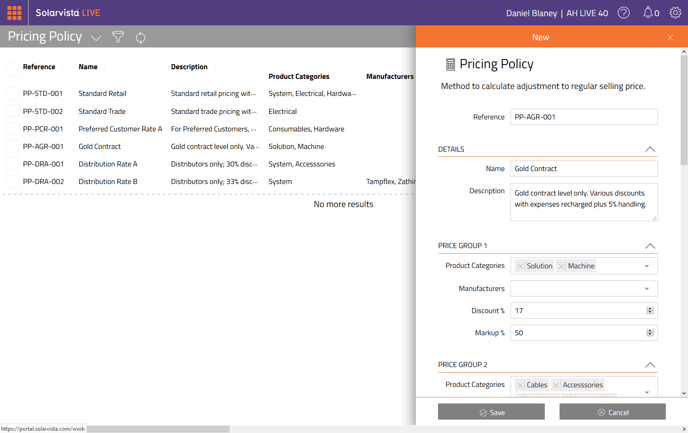
It is mandatory to setup either Discount Percentage or Mark-up Percentage to use within calculations that override the pricing from the standard Product record. Billing processes use the best information it can to determine the final selling price.
Up to three Price Groups are supported within each Pricing Policy; each one allowing multiple price mechanisms.
You can also enter Expense Categories that will be recharged to the Customer with an optional handling charge as a percentage. This value can be subject to a minimum charge and/or a maximum charge.
Pricing Policy records also have validity dates to control when the Pricing Policy should be applied. These can also be used to automatically “roll-over” pricing from one period to the next.
Where Pricing Policy Records are Used
The following files refer to Pricing Policy records so if you plan to use any of these, setting up the records in this file will be important or even critical:
Work Items:
- Generic Job
- Field Repair
- Depot Repair
- Installation
- Field Maintenance
- Internal Maintenance
- Field Task
Data Sources:
- Customer
- Recurring Work
Pre-requisite Files for Pricing Policy Records
When setting up Pricing Policy records, it is recommended to review the other data files that may need to be referred to by each record. These are the files that you may need to setup in advance:
- Categories (Products)
- Manufacturers
- Categories (Expense)
Field Descriptions for Pricing Policy Records
The ID section holds the unique ID for the record:
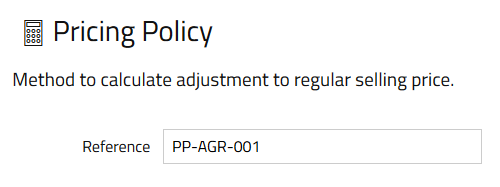
Reference - holds the unique ID for the record (most records in Solarvista have one of these). It cannot contain any spaces or non-standard characters. Once the record is saved, it is not possible to edit it afterwards. In most default situations, the Reference is automatically set using a counter sequence, however, you can setup your own if you prefer.
The Details section holds name and description:
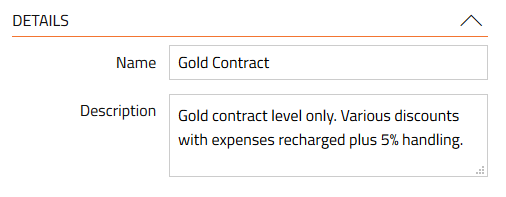
Name – the name of the Pricing Policy e.g. “Standard”, “Level A”, “Special Terms 1” etc.
Description – a description of the Pricing Policy to assist with selection when presented to users in lists.
The Price Group 1 section holds the first definition of the product categories and/or manufacturers where the pricing policy should be applied, together with associated mark-up or discount percentages:
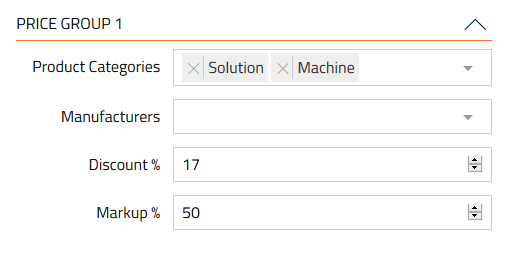
Product Categories – a list of Product Categories that are applicable to this group within this Pricing Policy. If not populated, the Pricing Policy is applied to ALL products in all Product Categories.
Manufacturers –contains a optional list of Manufacturers that are applicable to this group of this Pricing Policy. If not populated, the Pricing Policy is applied to ALL manufacturers.
Discount % – this percentage is discounted from the Sale Price taken from the respective Product record.
Markup % – this percentage is added to the Cost Price taken from the respective Product record. If this price does not exist, the Discount % is used instead.
The Price Group 2 section holds the second definition of the product categories and/or manufacturers where the pricing policy should be applied, together with associated mark-up or discount percentages:
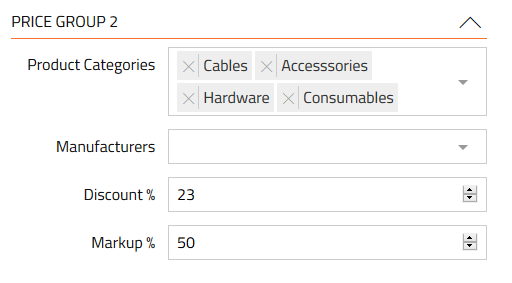
Product Categories – list of Product Categories that are applicable to this group within this Pricing Policy. If not populated, the Pricing Policy is applied to ALL products in all Product Categories.
Manufacturers – contains a optional list of Manufacturers that are applicable to this group of this Pricing Policy. If not populated, the Pricing Policy is applied to ALL manufacturers.
Discount % – this percentage is discounted from the Sale Price taken from the respective Product record.
Markup % – this percentage is added to the Cost Price taken from the respective Product record. If this price does not exist, the Discount % is used instead.
The Price Group 3 section holds the third definition of the product categories and/or manufacturers where the pricing policy should be applied, together with associated mark-up or discount percentages:

Product Categories –list of Product Categories that are applicable to this group within this Pricing Policy. If not populated, the Pricing Policy is applied to ALL products in all Product Categories.
Manufacturers – contains a optional list of Manufacturers that are applicable to this group of this Pricing Policy. If not populated, the Pricing Policy is applied to ALL manufacturers.
Discount % – this percentage is discounted from the Sale Price taken from the respective Product record.
Markup % – this percentage is added to the Cost Price taken from the respective Product record. If this price does not exist, the Discount % is used instead.
The Expense section holds information about expenses that should be recharged:
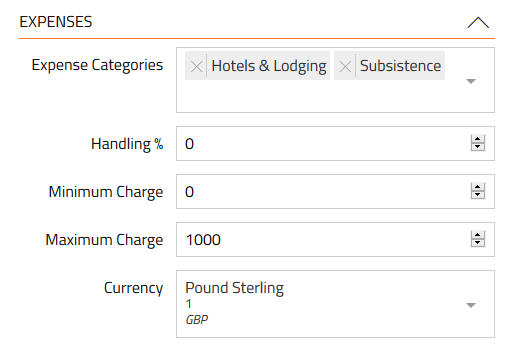
Categories – this holds a list of Expense Categories that should be recharged and added to any invoice created.
Handing % – this percentage is added to the Expense Amount. 0% means that the Expense is charged at the same cost.
Minimum Charge – this is the minimum amount charged. For example, if an Expense is submitted of 1.20 and this value is set to 2.50, then the value recharged is 2.50, not 1.20.
Maximum Charge – this is the maximum amount charged. For example, if an Expense is submitted of 100.00 and this value is set to 75.00, then the value recharged is 75.00, not 100.00.
Currency – the currency for the maximum and minimum values above.
The Validity section holds optional dates for validity of the Pricing Policy:
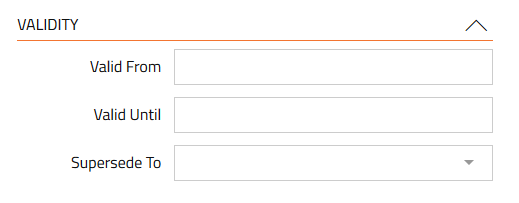
Valid From – the date from which the Pricing Policy should be valid. If not populated, the validity is assumed, subject to the Valid Until field.
Valid Until – the date until which the Pricing Policy should be valid. If not populated, the validity is assumed, subject to the Valid From field.
Supersede To – the Pricing Policy that should be used once this Pricing Policy expires (at the Valid Until date above).
The Other section holds miscellaneous additional information:
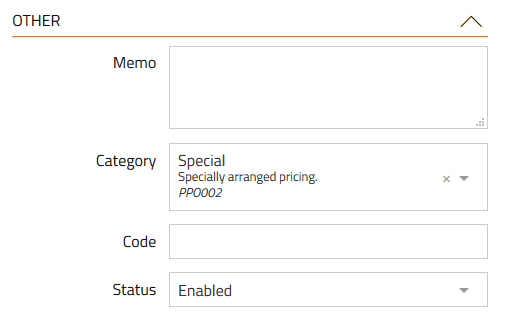
Memo – a free text field that can be used for any purpose.
Category – a category for the Pricing Policy e.g. ‘Standard”, “Special”. These are defined in the Categories file and set with a Type= “Pricing Policy”.
Code – used to hold an optional alternative ID code. This may be applicable in situations where information is being transferred to other systems via Connectors and the code here is used to identify the record to the other system.
Status – defines whether the record is visible or not. If set to “Enabled” they will appear but if set to “Disabled” they will not appear.
Creating a New Pricing Policy Record
To create a new Pricing Policy record:
- Click on the “Plus” button.

A menu will appear. - Within the “Data Sources” section, find “Pricing Policy”.

- Click on “Pricing Policy”.
- A new “empty” Service Level record will appear.
- Populate all fields as you require.
- Click on the “Create” button.

- You may need to refresh the page to see the new record in a view.

Editing a Pricing Policy Record
To edit a Pricing Policy record:
- From the main menu, select Pricing Policy.
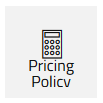
The default view for Pricing Policy will open. - Click on the Quick Filter button.

- Enter criteria for the Pricing Policy record you are looking for and click Apply button.

- The view will update. Find the record you are wanting to edit.
- Click anywhere on the row that shows the record. The record will open.
- You can edit any field that allows editing (some could be set to read only).
- Click on “Save” button to save changes.

Deleting a Pricing Policy Record
To delete a Pricing Policy record.
- From the main menu, select Pricing Policy. The default view for Pricing Policy will open.
- Click on the Quick Filter button.

- Enter criteria for the Pricing Policy record you are looking for and click Apply button.

- The view will update. Find the record you are wanting to delete.
- On the left side of the view is a column containing checkboxes.
- Check the box of the record you want to delete.
- Click the “Delete” button on the top right.

A slide in dialog will appear prompting you to confirm the delete, by typing in the word “DELETE” again. - To confirm, click the “Delete” button and the record (or records will be deleted).

Note: You cannot delete a Pricing Policy record that is already in use with a Work Item i.e. Jobs. You can delete Pricing Policy records referred to only by other Data Sources however this will leave those records without an associated to a valid Pricing Policy record. If this happens by accident, you can manually recreate the record ensuring the Reference is identical. You can also change the status of the record to prevent it appearing on screen in future whilst maintaining historical integrity.
Customising or Adding New Fields
Solarvista™ is built upon a uniquely flexible platform that allows you to edit fields (or remove them in some cases) as well as add your own fields. These new fields (or edited characteristics of existing fields) automatically become available within the web portal and the mobile apps. For more information, refer to the Customising section.
Importing Pricing Policy Data in Bulk using Import Tool
If you have a lot of Pricing Policy information to enter, you may prefer to upload this using the Import Tool that’s built into Solarvista. The Import Tool enables Pricing Policy records to be created from “CSV” text files. CSV files can be created from a wide range of popular applications including Microsoft Excel. For more information on importing data into Solarvista, please refer to the article here.